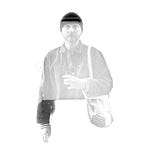Notes On Robert Bresson’s L’argent
I had the good fortune to revisit Robert Bresson’s final film, 1983’s L’argent theatrically this week, thanks to BFI Passport To Cinema season entitled ‘Before The Devil Knows You’re Dead’. Introduced by Philip Kemp, L’argent was screened on a pretty worn out old 35mm print; pink ruled, but it also gave it added character, and a griminess that one doesn’t often associate with the work of the meticulous French filmmaker.
L’argent might just be my most often seen Bresson film, after Pickpocket (a film which I consider to be a genuine contender for the title of “Greatest Of All Time”). It probably says quite a lot about my own personality that I find it to be an extremely emotional experience, which is something of a paradoxical reaction given the intentions of Bresson. Or perhaps that’s the point; maybe he was pushing for such an extremely non-emotional presentation that the result is instead inverted, and hugely affecting for those who speak the language of a Catholicism filtered thru humanism? This notion would certainly tie-in with the nature of the Catholic faith itself (and I speak as someone of the Catholic persuasion, if not one whose faith has lapsed). The aforementioned language of Bresson is the director’s greatest asset, and his toughest sell. The uninviting nature of the filmmaker’s style is at odds with pretty much every other recognisable form of cinema, and it’s often said that L’argent is Bresson at his most relentless and, to use an apt piece of terminology, his most unforgiving.
As such L’argent might just occupy a space deemed Bressonville, a nod to Jacques Tati’s Tativille; a world largely recognisable as that of the contemporary Paris at the contemporaneous time of the film’s production, but, and this is the crucial bit, skewed by their relative auteurist controllers. The Bressonian influence spreads far beyond the singular protagonists of A Man Escaped, The Trial Of Joan Of Arc or Pickpocket, and instead we see a world populated by Bresson’s ‘models’. See, the nurse that tends to Yvon after his suicide attempt, or Norbert’s father, who doles out his sons allowance with nary a glimpse toward anything, or the bank teller who methodically hands out further cash to Yvan’s final victim. Alas, it’s the unlikely narrators of L’argent, the prison letter openers, where this notion of a Bressonville really comes to life, to use an inappropriately lively adjective; one can easily imagine a Bresson film that revolves around the trials and tribulations of each of these characters.
In his introduction to L’argent Kemp highlighted the idea that many of the male performers in the films looked alike, and even went as far as to throw out an intriguing clone theory. Is it a coincidence that each of the major characters in the film look alike, or, as Kemp hypothesises, is Bresson perhaps suggesting that ultimately we’re all the same, and the misfortunes afforded his protagonist could happen to anyone, anywhere, anytime? It’s a neat idea, and one that is impossible not to contemplate during viewing once the similarity is highlighted.
